To fallen fellow sailors, a then youngster
called Robin, and a classic topsail schooner
When I started this column in July 2006, I said that modeling
was about `people’ – of course it is, for models and
the sailing of them can’t happen without human involvement.
As this is the month of Christmas, just as a reminder to each
and every one of us who sail at whichever lake or pond we sail
on, in whichever land we may happen to be domiciled, not one of
us is immortal. Each day we sail is one day less that we have
left in our sailing calendar and we know not when nor
where we will be called upon to finally slip our moorings.
Many have died in the past few years and I choose to honour those
who like ourselves found pleasure in each others company while
enjoying the sailing of model yachts, and to do so by way of two
fallen fellow model sailors both friends-never-met of mine, and
another friend who wrote books on boats, built models, drew plans,
painted pictures of square-riggers and was a master at marine
photography. David Blinkhorn of Lancashire,
England seen below (top left) died some years ago, as did Sandy
Cousins of Scotland (below lower left) and my dear
friend, Clifford Hawkins of Auckland
(below lower right) stand for all those others who built beautiful
models and sailed the many lakes and ponds before slipping the
surly bonds of earth. I choose not to mention others who died
but let us quietly remember all those no longer with us whom each
of us had the good fortune to know. Cliff died aged 93 on March
13th this year and his lovely painting found at the top of this
column last year as well as his photographic study of the South
Seas schooner, Tiare Taporo at rest are reproduced to
honour him and all those no longer with us.
|
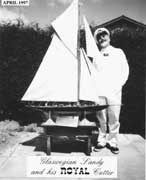 |
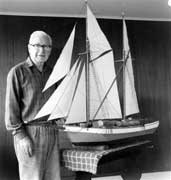
|
Sensible advice I think, that given by the locals (for those
visiting the island of Saint Marten in the Dutch Caribbean) is
simply to
`lay on de beach an laaf
and smile plenty’
Robin Redhead of London was a long term reader of my now ended
magazine Windling World, and around 1940 was photographed
(above) launching a 3-masted barque bought in Hamleys famous toy
shop as a 3-masted Bermudan schooner. How many of us today can
unearth that kind of priceless photo of ourselves sailing a model
yacht when we were very young? It was steered free with a swing
rudder and the photo of Robin was taken at the Round Pond in Kensington.
These days Robin sails one or more of a trio of lovely Southwold-style
model yachts that he owns.
I just love it! Larry Pullen wrote in Duckworks: “My pappy
told me, boy if you fool around with the wind, sooner or later
you’re going to get blowed!” True or false? Think
about it, I reckon Larry’s dad was right on the mark!
The Huia re-created. Sailing colleague and fellow Auckland
Ancient Mariner, Derek Nicholson (seen above with his
earlier model of the schooner Creole has done it again,
this time creating a wonderful sailing replica of the once famous
New Zealand topsail schooner Huia. It's appearance I
have to tell you brought on an immediate and prolonged case of
`Drool Dribble', that malady that afflicts some of us upon inspection
of stunning model sailing ships made by others. The first three
photos above show the model. Take a quick look, now scroll down
quickly! That's it, you should be relatively safe.
 |
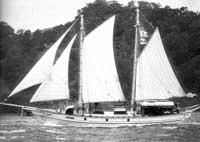
A writer's favourite |
Were I ever to select and rate six top models as my favourites,
Richard Gross’s lovely schooner, Maggie of Matakana
(seen above) would certainly be well up in the selection, she
just sails so well, looks so damn good and always commands the
attention of onlookers strolling the pondside pavement at our
Onepoto lake,. home of the Auckland Ancient Mariners
group. Because this model is so attractive in style I think I
should warn you, this is not a boat for the raw beginner to attempt
to build and I say that because I know that many will instantly
feel `that’s the boat for me!’
Richard Gross is very `handy’ in the model building area
– an ex Dental surgeon he is used to intricate work. He
and his wife have a beach house north of Auckland where the sailing
around the Hauraki Gulf is wonderful. There he was to notice a
certain schooner with clean lines and a very `different’
look about her. She was Maggie of Whitford, (seen above
under sail) a New Zealand built scow-like Chesapeake Bay gaff
schooner, and she became the boat of which he would construct
a new model. With side plans of the fullsize 80’ long boat
(and some approximate measurements but no frame shapes), after
using a computer boat design package downloaded free of the internet
this then provided him with hull panels in flat format. Enlarging
of the plan to the required size, Richard then stitched the panels
together using copper wire ties, then glued them with resin on
the inside removing the ties before the glue set totally.
The sails are made of polycotton and are on longer masts for
better light weather performance, the winch, servo and rudder
are below the deckhouse floor and as the windows of the deckhouse
floor clear, the inside has been made as close to the fullsize
boat as possible. Maggie of Whitford was built and is
owned and sailed by Brian Owen of the Mahurangi Cruising Club.
The length of Richard’s model is 1150mm, 1480 including
the bowsprit. She carries 3.5kg on the keel and has an all up
weight of 8kg.
On Cape Horn, Bernard Moitessier in his book
The
Long Way wrote: `A great Cape, for us, can’t
be expressed in longitude and latitude alone. A great Cape has
a soul with very soft, very violent shadows and colours. A soul
as smooth as a child’s, as hard as a criminal’s. And
that is why we go!’
The
larger than usual
R Tucker Thompson |
|
At the time that the late Rex Cotterell his 1/9th scale model,
the real gaff-rigged square topsail schooner, all 85’ of
her, was based in the North Island of New Zealand’s Bay
of Islands, the fullsize boat launched in 1985. Rex was a ship-loving
model yacht fanatic and in 1988 he set out to build a larger than
usual model of the R Tucker Thompson. Two metres long
plus a 660mm bowsprit he wanted to sail it in the same estuary
where the original was launched. The model was huge and really
impressive on the water. When sailed in a good breeze Rex needed
an outboard powered dinghy in order to keep up with her.
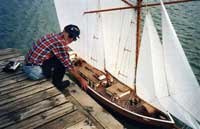
Rex and his model of the
schooner |
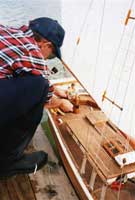 Now stop bloody falling over man!
Now stop bloody falling over man! |
I remember meeting Rex on arrangement for the first time at the
Panmure basin in Auckland some years ago, where the rigging time
for the model I discovered was over an hour and launching the
model required a small trailer which went into the water. With
some 60lbs of ballast aboard and carried internally, with the
amount of sail she carried, just launching her was more than a
handful. The model was made of fiberglass over a ply frame and
I remember seeing a wonderful photograph of the model blasting
along somewhere, her nylon cloth sails filled, her bow cutting
the water. After Rex died the model was placed in Modelworld
where the lack of sufficient water and space was insufficient
to get her to really perform under sail, but these photos (most
of them mine) taken earlier are testimony to a much remembered
and admired model.
|

|
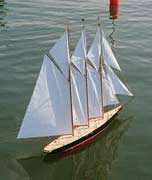 |
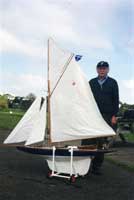
|
Lloyd 'Swede' Johnson of California with his Garden `Toadstool’
design schooner (top left), Buck McClellan of Maryland, USA's
model of the famous schooner Atlantic, (below left) and
to the right of that, Aucklander, Tom Simpson with Thistle,
another truly lovely and good performing model.
This was an event of fantasy, one that evolved out of the mind
perhaps of Larry Blotta, the model yot spotta whose best-seller-to-be
book intended to compete with Harry Potter also never
came to reality. (A bit of a dreamer Larry is!) Drawn for me by
my friend, Derek Cookson it depicts what might have eventuated
were a model yacht ocean race held with all skippers operating
from on board the same boat! That one, and the second drawing
`borrowed’ from the US Vintage Model Yacht Group’s
publication, The Model Yacht which accurately portrays
how wrong non-model yacht sailors can be about our hobby, are
included just to remind each other of the importance of not taking
ourselves too seriously!
Think about it, but without our fertile imagination, each of
us is no more than a small and scrawny, dull and boring underground
Ethiopian coffee bean termite! All that is left for me to do,
is to wish everyone who journeys with me each month into the world
of model sailing boats, as well as others who may have just chanced
upon the column, a very happy Christmas and a healthy and equally
happy 2008. To Chuck Leinweber, my Publisher and friend, as well
as to his wife Sandra, warmest greetings and thanks for providing
my writings with a home over the last eighteen months. Gosh, is
it already that long?
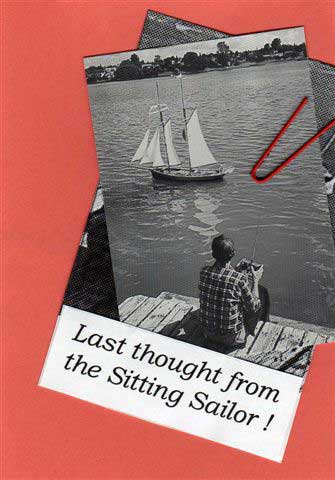
Good Grief, I must get back home to practice for my annual home
concert where I sing and play Danny Boy on the strings of my wife’s
egg slicer and the neighbours cat immediately migrates to Marbella!
|

